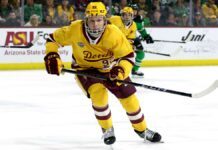Heading into free agency, nearly every Leafs fan knew that Nonis wanted to bring in David Clarkson, considered your prototypical Carlyle guy. Well, I’m sure you all know that Nonis got his man, and at a hefty $5.25 million cap hit for 7 years. There’s been much discussion since the signing about the contract Nonis gave to Clarkson and I don’t particularly want to beat a dead horse. So, without really delving into the subject of whether or not I think he’s worth that money or term, I want to give Leafs fans a look into what Clarkson brings to the table.
HOW WAS HE USED?
The following is a table of Clarkson’s ice-time over the past 4 years:
| Season | ES TOI/G | PP TOI/G | PK TOI/G | Rank among NJ forwards (ES/PP/PK) |
| 2009-10 | 12:04 | 2:22 | 0:00 | (11/7/18) |
| 2010-11 | 11:56 | 1:39 | 0:00 | (11/11/18) |
| 2011-12 | 13:17 | 3:03 | 0:01 | (9/4/18) |
| 2012-13 | 14:01 | 3:33 | 0:01 | (3/3/15) |
What do these numbers tell us? Well, the first thing to note is that Clarkson is not a guy who sees the ice when his team is down a man. He is, however, a guy that who, over the past two seasons, has seen extensive power play time (I’ll talk about how he did in that time in the next section). His use in even strength situations has taken big steps forward in each of the past two seasons (+1:21 from 2010-11 to 2011-12 and +0:44 from 2011-12 to 2012-13). Where would his most recent numbers place him on the Leafs squad? His 2012-13 ES TOI/G would have ranked him 5th among forwards behind Nik Kulemin and ahead of Mikhail Grabovski. His PP TOI/G would have him ranked 1st ahead of Phil Kessel by 0:15 and beating second place Tyler Bozak by over 0:30.
When judging the difficulty of Clarkson’s minutes based on his offensive-zone start percentage, it’s understandable that one might think he’s been sheltered: his lowest figure in the past five years is 49.3% in 2010-11. However, he’s been consistently in the back half of the team using that measure. It does not appear that the Devils have forwards that consistently line-up in the defensive end, like our own Jay McClement or Kulemin. The closest they had was David Steckel in 2010-11 and he wasn’t below 40% (in fact he was the only forward lower than Clarkson that year).
The next component of judging the difficulty of a player’s minutes is his quality of competition. Clarkson has faced some pretty easy competition (relative to his teammates) during his time in New Jersey: He finished 10th among forwards (min 10GP) in 2009-10, 11th in 2010-11, 9th in 2011-12 and 12th in 2012-13.
Last up, we need to examine which players Clarkson had for linemates. The following table shows the forwards Clarkson was most commonly paired with over the past few seasons:
| Season | Linemate | Linemate TOI % | Linemate | Linemate TOI % | Linemate | Linemate TOI % |
| 2009-10 | Niedermayer | 49.2 | Rolston | 28.6 | Zubrus | 19.6 |
| 2010-11 | Pelley | 37.2 | Zubrus | 20.7 | Sestito | 20.2 |
| 2011-12 | Tedenby | 25.8 | Sykora | 23.4 | Carter | 21.5 |
| 2012-13 | Elias | 65.1 | Zajac | 42.5 | Henrique | 34.6 |
The 2012-13 season saw Clarkson with consistent line mates in Travis Zajac and Patrik Elias. Prior to that, Clarkson appeared to move around quite a bit, seeing time with such offensive dynamos as Rod Pelley, Ryan Carter and Mattias Tedenby. In fact, over the past four seasons Clarkson has only spent at least 40% of his TOI in a season with a player three times: once in 2009-10 with Rob Niedermayer and with both Elias and Zajac this season.
Let’s take the bigger picture by putting these pieces together: Clarkson’s role at even strength has been strongly trending upwards of late, he isn’t a penalty killer but sees enormous ice-time on the man advantage, his linemates were only stable (and skilled) this past season, and he faced relatively sheltered minutes in New Jersey.
HOW DID HE DO?
A quick look at Clarkson’s possession numbers show him finishing among forwards (relative to his teammates, so using Corsi Rel) 14th in 2009-10 with a negative number, 10th in 2010-11 with a very small negative, 9th in 2011-12 with a positive number, and 1st this year with a massive positive . It’s worth noting that setting aside his relative position (so switching to Corsi On), Clarkson has been a positive possession player (on ice for more shots for than shots against) each of the past three years.
Now we’ll look at Clarkson’s production statistics. The following table shows Clarkson’s production in ES/60 among New Jersey forwards with a minimum of 10GP:
| Season | G/60 | A1/60 | A2/60 | P/60 | Rank among NJ forwards (G/A1/A2/P) |
| 2009-10 | 0.87 | 0.54 | 0.54 | 1.95 | (5/10/6/6) |
| 2010-11 | 0.67 | 0.18 | 0.12 | 0.98 | (5/15/11/11) |
| 2011-12 | 1.21 | 0.17 | 0.29 | 1.66 | (1/14/10/6) |
| 2012-13 | 0.83 | 0.32 | 0.37 | 1.47 | (2/12/4/4) |
To throw in some context regarding Clarkson’s linemates’ production this season, Elias finished 1st in P/60 with 1.84 and Zajac finished 7th with 1.24. The good news here is that Clarkson can score and that he’s not too terrible reliant on secondary assists in his point totals. The bad news is that he doesn’t appear to be great at distributing the puck and setting up his linemates.
Clarkson’s career SH% is 9.4% but looking at it year-to-year, it’s all over the place. Considering his volatile SH%, it’s interesting to note that Clarkson finished 4th this season in shots on goal (with a SH% of 8.3%), following up last season where he finished 45th (with a SH% of 13.2%). It appears as though he’s determined to score, whether it’s by volume or precision.
Giving Clarkson’s PDO (on-ice SH% + on-ice SV%; a measure of luck among other things) a glance shows that he’s been below 1000 each of the past three seasons, an indication that he may be having some bad luck (or that his natural PDO is in fact lower than 1000). Clarkson’s on-ice SH% was 13th among New Jersey forwards this season (which linemates Zajac and Elias close by), 9th in 2011-12 (despite shooting a 13.2% himself) and 14th during the 2010-11 season. It’s possible that these numbers aren’t helped by Clarkson’s unskilled linemates (prior to this season) and a New Jersey defense that contributed just 29 goals combined over the past two seasons. (Phaneuf has 21 alone).
There’s one last element of Clarkson’s game that I want to look at from a production standpoint, and that’s his power play production. This past season Clarkson had the highest G/60 with the man advantage (among NJ forwards min. 10GP) and finished with 3rd amongst NJ forwards with PP points. Last season he finished 6th in power play G/60 and P/60 (amongst NJ forwards min. 10GP).
Overall, what can we say about Clarkson’s production? He’s a positive possession player; he can score goals but doesn’t really set up his linemates; he shoots the puck a lot but his SH% is inconsistent; and he’s pretty good on the power play.
WHERE DOES HE FIT HERE?
David Clarkson has produced like a top-six forward in three of the past four seasons (and scored like one in all four). At even strength this season Clarkson shot poorly from within 10 ft. but generated 15 shots, while the season prior he scored 6 goals on 28 shots (21.4% SH%); you can expect to see Clarkson mucking it up around the net, likely flanked by Kadri and Lupul. Odds are that line will play some sheltered minutes in terms of quality of competition and o-zone starts if Carlyle can swing it.
It’s also a pretty good bet that Clarkson will continue to see extensive power play time. This past season on the power play, Clarkson scored 4 goals on 11 shots from within 10 ft. The entire Leafs team scored 5 on 20 from within 10 ft. So this season, when the Leafs are on the power play you’ll just need to look to the opposing team’s crease to find Clarkson.
Thanks for sticking around to the end, I know it was long (I prefer thorough) but I really wanted to give Leafs fans an in-depth look at David Clarkson. Love it or hate it, number 71 (Clarkson’s chosen number) is going to be around for a while.
| Scoring Stats | Goals | Assists | Ice Time | ||||||||||||||||||
|---|---|---|---|---|---|---|---|---|---|---|---|---|---|---|---|---|---|---|---|---|---|
| Season | Age | Tm | Lg | GP | G | A | PTS | GC | +/- | PIM | EV | PP | SH | GW | EV | SH | PP | S | S% | TOI | ATOI |
| 2006-07 | 22 | NJD | NHL | 7 | 3 | 1 | 4 | 2 | -1 | 6 | 1 | 2 | 0 | 1 | 1 | 0 | 0 | 18 | 16.7 | 119 | 17:02 |
| 2007-08 | 23 | NJD | NHL | 81 | 9 | 13 | 22 | 8 | 1 | 183 | 9 | 0 | 0 | 1 | 11 | 0 | 2 | 151 | 6.0 | 975 | 12:02 |
| 2008-09 | 24 | NJD | NHL | 82 | 17 | 15 | 32 | 13 | -1 | 164 | 13 | 4 | 0 | 3 | 13 | 0 | 2 | 158 | 10.8 | 988 | 12:03 |
| 2009-10 | 25 | NJD | NHL | 46 | 11 | 13 | 24 | 9 | 3 | 85 | 8 | 3 | 0 | 2 | 10 | 0 | 3 | 106 | 10.4 | 664 | 14:27 |
| 2010-11 | 26 | NJD | NHL | 82 | 12 | 6 | 18 | 8 | -20 | 116 | 11 | 1 | 0 | 1 | 5 | 0 | 1 | 192 | 6.3 | 1117 | 13:37 |
| 2011-12 | 27 | NJD | NHL | 80 | 30 | 16 | 46 | 20 | -8 | 138 | 22 | 8 | 0 | 7 | 8 | 0 | 8 | 228 | 13.2 | 1309 | 16:22 |
| 2012-13 | 28 | NJD | NHL | 48 | 15 | 9 | 24 | 11 | -6 | 78 | 9 | 6 | 0 | 5 | 7 | 0 | 2 | 180 | 8.3 | 844 | 17:36 |
| Career | NHL | 426 | 97 | 73 | 170 | 72 | -32 | 770 | 73 | 24 | 0 | 20 | 55 | 0 | 18 | 1033 | 9.4 | 6017 | 14:07 | ||

































